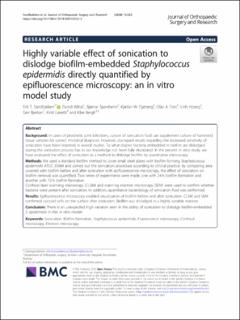| dc.contributor.author | Sandbakken, Erik Thorvaldsen | |
| dc.contributor.author | Witsø, Eivind | |
| dc.contributor.author | Sporsheim, Bjørnar | |
| dc.contributor.author | Egeberg, Kjartan Wøllo | |
| dc.contributor.author | Foss, Olav A. | |
| dc.contributor.author | Hoang, Linh | |
| dc.contributor.author | Bjerkan, Geir | |
| dc.contributor.author | Løseth, Kirsti | |
| dc.contributor.author | Bergh, Kåre | |
| dc.date.accessioned | 2021-02-04T12:33:41Z | |
| dc.date.available | 2021-02-04T12:33:41Z | |
| dc.date.created | 2020-11-21T18:25:41Z | |
| dc.date.issued | 2020 | |
| dc.identifier.citation | Journal of Orthopaedic Surgery and Research. 2020, 15:522 1-9. | en_US |
| dc.identifier.issn | 1749-799X | |
| dc.identifier.uri | https://hdl.handle.net/11250/2726170 | |
| dc.description.abstract | Background
In cases of prosthetic joint infections, culture of sonication fluid can supplement culture of harvested tissue samples for correct microbial diagnosis. However, discrepant results regarding the increased sensitivity of sonication have been reported in several studies. To what degree bacteria embedded in biofilm are dislodged during the sonication process has to our knowledge not been fully elucidated. In the present in vitro study, we have evaluated the effect of sonication as a method to dislodge biofilm by quantitative microscopy.
Methods
We used a standard biofilm method to cover small steel plates with biofilm forming Staphylococcus epidermidis ATCC 35984 and carried out the sonication procedure according to clinical practice. By comparing area covered with biofilm before and after sonication with epifluorescence microscopy, the effect of sonication on biofilm removal was quantified. Two series of experiments were made, one with 24-h biofilm formation and another with 72-h biofilm formation.
Confocal laser scanning microscopy (CLSM) and scanning electron microscopy (SEM) were used to confirm whether bacteria were present after sonication. In addition, quantitative bacteriology of sonication fluid was performed.
Results
Epifluorescence microscopy enabled visualization of biofilm before and after sonication. CLSM and SEM confirmed coccoid cells on the surface after sonication. Biofilm was dislodged in a highly variable manner.
Conclusion
There is an unexpected high variation seen in the ability of sonication to dislodge biofilm-embedded S. epidermidis in this in vitro model. | en_US |
| dc.language.iso | eng | en_US |
| dc.publisher | BMC | en_US |
| dc.rights | Navngivelse 4.0 Internasjonal | * |
| dc.rights.uri | http://creativecommons.org/licenses/by/4.0/deed.no | * |
| dc.title | Highly variable effect of sonication to dislodge biofilm-embedded Staphylococcus epidermidis directly quantified by epifluorescence microscopy: an in vitro model study | en_US |
| dc.type | Peer reviewed | en_US |
| dc.type | Journal article | en_US |
| dc.description.version | publishedVersion | en_US |
| dc.source.pagenumber | 1-9 | en_US |
| dc.source.volume | 15:522 | en_US |
| dc.source.journal | Journal of Orthopaedic Surgery and Research | en_US |
| dc.identifier.doi | 10.1186/s13018-020-02052-3 | |
| dc.identifier.cristin | 1850695 | |
| dc.description.localcode | © The Author(s). 2020 Open Access This article is licensed under a Creative Commons Attribution 4.0 International License, | en_US |
| cristin.ispublished | true | |
| cristin.fulltext | original | |
| cristin.qualitycode | 1 | |

